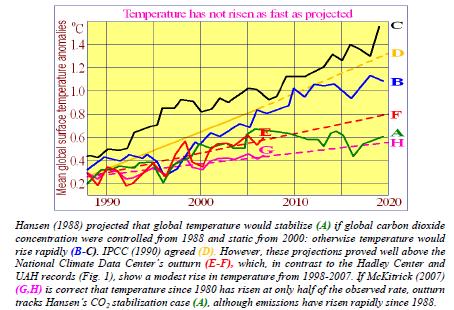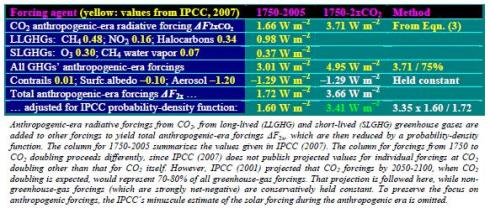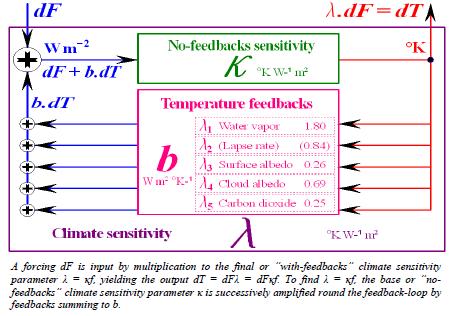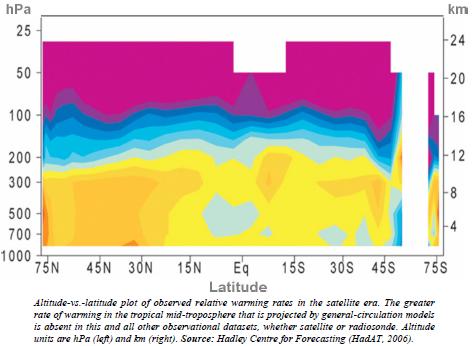Link to Complete 321-Page PDF Special Report
Marc Morano
More than 1000 dissenting scientists (updates previous 700 scientist report) from around the globe have now challenged man-made global warming claims made by the United Nations Intergovernmental Panel on Climate Change (IPCC) and former Vice President Al Gore. This new 2010 320-page Climate Depot Special Report — updated from 2007′s groundbreaking U.S. Senate Report of over 400 scientists who voiced skepticism about the so-called global warming “consensus” — features the skeptical voices of over 1000 international scientists, including many current and former UN IPCC scientists, who have now turned against the UN IPCC.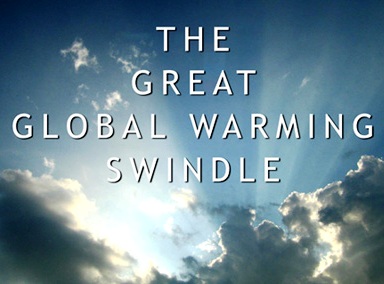
This updated 2010 report includes a dramatic increase of over 300 additional (and growing) scientists and climate researchers since the last update in March 2009. This report’s release coincides with the 2010 UN global warming summit being held in Cancun.
The more than 300 additional scientists added to this report since March 2009 (21 months ago), represents an average of nearly four skeptical scientists a week speaking out publicly. The well over 1000 dissenting scientists are almost 20 times the number of UN scientists (52) who authored the media-hyped IPCC 2007 Summary for Policymakers.
The chorus of skeptical scientific voices grew louder in 2010 as the Climategate scandal — which involved the upper echelon of UN IPCC scientists — detonated upon on the international climate movement. “I view Climategate as science fraud, pure and simple,” said noted Princeton Physicist Dr. Robert Austin shortly after the scandal broke. Climategate prompted UN IPCC scientists to turn on each other. UN IPCC scientist Eduardo Zorita publicly declared that his Climategate colleagues Michael Mann and Phil Jones “should be barred from the IPCC process…They are not credible anymore.” Zorita also noted how insular the IPCC science had become. “By writing these lines I will just probably achieve that a few of my future studies will, again, not see the light of publication,” Zorita wrote. A UN lead author Richard Tol lead author grew disillusioned with the IPCC and lamented that it had been “captured” and demanded that “the Chair of IPCC and the Chairs of the IPCC Working Groups should be removed.” Tol also publicly called for the “suspension” of IPCC Process in 2010 after being invited by the UN to participate as lead author again in the next IPCC Report.
Other UN scientists were more blunt. South African UN scientist declared the UN IPCC a “worthless carcass” and noted IPCC chair Pachauri is in “disgrace”. He also explained that the “fraudulent science continues to be exposed.” Alexander, a former member of the UN Scientific and Technical Committee on Natural Disasters harshly critiqued the UN. “‘I was subjected to vilification tactics at the time. I persisted. Now, at long last, my persistence has been rewarded…There is no believable evidence to support [the IPCC] claims. I rest my case!” See: S. African UN Scientist Calls it! ‘Climate change – RIP: Cause of Death: No scientifically believable evidence…Deliberate manipulation to suit political objectives’ [Also see: New Report: UN Scientists Speak Out On Global Warming -- As Skeptics!] Geologist Dr. Don Easterbrook, a professor of geology at Western Washington University, summed up the scandal on December 3, 2010: “The corruption within the IPCC revealed by the Climategate scandal, the doctoring of data and the refusal to admit mistakes have so severely tainted the IPCC that it is no longer a credible agency.”
Selected Highlights of the Updated 2010 Report featuring over 1000 international scientists dissenting from man-made climate fears:
“We’re not scientifically there yet. Despite what you may have heard in the media, there is nothing like a consensus of scientific opinion that this is a problem. Because there is natural variability in the weather, you cannot statistically know for another 150 years.” — UN IPCC’s Tom Tripp, a member of the UN IPCC since 2004 and listed as one of the lead authors and serves as the Director of Technical Services & Development for U.S. Magnesium.
“Any reasonable scientific analysis must conclude the basic theory wrong!!” — NASA Scientist Dr. Leonard Weinstein who worked 35 years at the NASA Langley Research Center and finished his career there as a Senior Research Scientist. Weinstein, is presently a Senior Research Fellow at the National Institute of Aerospace.
“Please remain calm: The Earth will heal itself — Climate is beyond our power to control…Earth doesn’t care about governments or their legislation. You can’t find much actual global warming in present-day weather observations. Climate change is a matter of geologic time, something that the earth routinely does on its own without asking anyone’s permission or explaining itself.” — Nobel Prize-Winning Stanford University Physicist Dr. Robert B. Laughlin, who won the Nobel Prize for physics in 1998, and was formerly a research scientist at Lawrence Livermore National Laboratory.
“In essence, the jig is up. The whole thing is a fraud. And even the fraudsters that fudged data are admitting to temperature history that they used to say didn’t happen…Perhaps what has doomed the Climategate fraudsters the most was their brazenness in fudging the data” — Dr. Christopher J. Kobus, Associate Professor of Mechanical Engineering at Oakland University, specializes in alternative energy, thermal transport phenomena, two-phase flow and fluid and thermal energy systems.
“The energy mankind generates is so small compared to that overall energy budget that it simply cannot affect the climate…The planet’s climate is doing its own thing, but we cannot pinpoint significant trends in changes to it because it dates back millions of years while the study of it began only recently. We are children of the Sun; we simply lack data to draw the proper conclusions.” — Russian Scientist Dr. Anatoly Levitin, the head of geomagnetic variations laboratory at the Institute of Terrestrial Magnetism, Ionosphere and Radiowave Propagation of the Russian Academy of Sciences.
“Hundreds of billion dollars have been wasted with the attempt of imposing a Anthropogenic Global Warming (AGW) theory that is not supported by physical world evidences…AGW has been forcefully imposed by means of a barrage of scare stories and indoctrination that begins in the elementary school textbooks.” — Brazilian Geologist Geraldo Luís Lino, who authored the 2009 book “The Global Warming Fraud: How a Natural Phenomenon Was Converted into a False World Emergency.”
“I am an environmentalist,” but “I must disagree with Mr. Gore” — Chemistry Professor Dr. Mary Mumper, the chair of the Chemistry Department at Frostburg State University in Maryland, during her presentation titled “Anthropogenic Carbon Dioxide and Global Warming, the Skeptic’s View.”
“I am ashamed of what climate science has become today,” The science “community is relying on an inadequate model to blame CO2 and innocent citizens for global warming in order to generate funding and to gain attention. If this is what ‘science’ has become today, I, as a scientist, am ashamed…Science is too important for our society to be misused in the way it has been done within the Climate Science Community.” Swedish Climatologist Dr. Hans Jelbring,
“Those who call themselves ‘Green planet advocates’ should be arguing for a CO2- fertilized atmosphere, not a CO2-starved atmosphere…Diversity increases when the planet was warm AND had high CO2 atmospheric content…Al Gore’s personal behavior supports a green planet – his enormous energy use with his 4 homes and his bizjet, does indeed help make the planet greener. Kudos, Al for doing your part to save the planet.” — Renowned engineer and aviation/space pioneer Burt Rutan, who was named “100 most influential people in the world, 2004″ by Time Magazine and Newsweek called him “the man responsible for more innovations in modern aviation than any living engineer.”
“Global warming is the central tenet of this new belief system in much the same way that the Resurrection is the central tenet of Christianity. Al Gore has taken a role corresponding to that of St Paul in proselytizing the new faith…My skepticism about AGW arises from the fact that as a physicist who has worked in closely related areas, I know how poor the underlying science is. In effect the scientific method has been abandoned in this field.” — Atmospheric Physicist Dr. John Reid, who worked with Australia’s CSIRO’s (Commonwealth Scientific and Industrial Research Organization) Division of Oceanography and worked in surface gravity waves (ocean waves) research.
“We maintain there is no reason whatsoever to worry about man-made climate change, because there is no evidence whatsoever that such a thing is happening.” — Greek Earth scientists Antonis Christofides and Nikos Mamassis of the National Technical University of Athens’ Department of Water Resources and Environmental Engineering.
“There are clear cycles during which both temperature and salinity rise and fall. These cycles are related to solar activity…In my opinion and that of our institute, the problems connected to the current stage of warming are being exaggerated. What we are dealing with is not a global warming of the atmosphere or of the oceans.” — Biologist Pavel Makarevich of the Biological Institute of the Russian Academy of Sciences
“Because the greenhouse effect is temporary rather than permanent, predictions of significant global warming in the 21st century by IPCC are not supported by the data.” — Hebrew University Professor Dr. Michael Beenstock an honorary fellow with Institute for Economic Affairs who published a study challenging man-made global warming claims titled “Polynomial Cointegration Tests of the Anthropogenic Theory of Global Warming.”
“The whole idea of anthropogenic global warming is completely unfounded. There appears to have been money gained by Michael Mann, Al Gore and UN IPCC’s Rajendra Pachauri as a consequence of this deception, so it’s fraud.” — South African astrophysicist Hilton Ratcliffe, a member of the Astronomical Society of Southern Africa (ASSA) and the Astronomical Society of the Pacific and a Fellow of the British Institute of Physics.
End Selected Excerpts
The rapidity of the global warming establishment’s collapse would have been unheard of just two years ago. Prominent physicist Hal Lewis resigned from American Physical Society, calling “Global warming the greatest and most successful pseudoscientific fraud I have seen in my long life.” UK astrophysicist Piers Corbyn was blunt about what Climategate revealed: “The case for climate fears is blown to smithereens…the whole theory should be destroyed and discarded and UN conference should be closed.”
Even the usually reliable news media has started questioning the global warming claims. Newsweek Magazine wrote in May 2010 about the “uncertain science” and how “climate researchers have lost the public’s trust” from a “cascade of scandals” from the UN IPCC. Newsweek compared the leaders of the climate science community to “used-car salesmen.”Once celebrated climate researchers are feeling like the used-car salesmen” and the magazine noted that “some of IPCC’s most-quoted data and recommendations were taken straight out of unchecked activist brochures, newspaper articles…Just as damaging, many climate scientists have responded to critiques by questioning the integrity of their critics, rather than by supplying data and reasoned arguments.” For full list of Climategate related scandals See: Climate Scandals: List Of 94 Climate-Gates — 94 climate-gates total — 28 new gates — 145 links to reports with details
As the global warming edifice crumbled in 2010, the movement lost one of its leading lights due to the Climategate revelations. Dr. Judith Curry, the chair of Earth & Atmospheric Sciences at GA Institute of Tech, explained her defection from the global warming activist movement. “There is ‘a lack of willingness in the climate change community to steer away from groupthink…They are setting themselves up as second-rate scientists by not engaging, Curry wrote in 2010. Curry critiqued the UN IPCC for promoting “dogma” and clinging to the “religious importance” of the IPCC’s claims. “They will tolerate no dissent and seek to trample anyone who challenges them,” Curry lamented. “The IPCC assessment process had a substantial element of schoolyard bullies, trying to insulate their shoddy science from outside scrutiny and attacks by skeptics…the IPCC and its conclusions were set on a track to become a self fulfilling prophecy,” Curry wrote. Curry called the Climategate fallout nothing short of a “rather spectacular unraveling of the climate change juggernaut…I immediately realized that [Climategate] could bring down the IPCC…I became concerned about the integrity of our entire field…While my colleagues seemed focused on protecting the reputations of the scientists involved and assuring people that the ‘science hadn’t changed.” [Also see: 'High Priestess of Global Warming' No More! Former Warmist Judith Curry Admits To Being 'Duped Into Supporting IPCC' - 'If the IPCC is dogma, then count me in as a heretic'] [Note: There were many Cilmategate inquiries that sought to downplay Climategate, but they fell short of their goal and were labeled as nothing more than the "global warming establishment exonerating the global warming establishment." See here, here, and here. The InterAcademy Council (IAC) was the most competent of the inquires.]
As new data and science continued to call into question man-made global warming claims, one of the movements leading fear promoters shocked the world by beginning to retreat from his dire predictions. Green guru James Lovelock warned in 2007 that ” “Before this century is over, billions of us will die and the few breeding pairs of people that survive will be in the Arctic.” Lovelock illustrates how the climate of the climate change movement has been transformed in the last year. In May 2010, Lovelock shocked the world by announcing: “Everybody might be wrong. Climate change may not happen as fast as we thought, and we may have 1,000 years to sort it out.” Lovelock went even father by noting how the science of global warming is in its infancy and “we haven’t got the physics worked out yet.” “The great climate science centers around the world are more than well aware how weak their science is. If you talk to them privately they’re scared stiff of the fact that they don’t really know what the clouds and the aerosols are doing. They could be absolutely running the show. We haven’t got the physics worked out yet,” Lovelock explained. Lovelock now openly praises skeptics and worries that climate fear promotion is akin to religion. In March of 2010, Lovelock said: “The skeptics have kept us sane…They have kept us from regarding climate science as a religion. It had gone too far that way.” [Note: Even the UN has grown more uncertain about the science. See: UN Fears (More) Global Cooling Commeth! IPCC Scientist Warns UN: We may be about to enter 'one or even 2 decades during which temps cool' -- Admits 'Jury is still out' on ocean cycle's temp impact!]
More woes for the movement were felt when left-leaning environmental activists began jumping ship. See: Left-wing Env. Scientist Denis Rancourt Bails Out Of Global Warming Movement: Declares it a ‘corrupt social phenomenon…strictly an imaginary problem of the 1st World middleclass’ & Meet the green who doubts ‘The Science’: Environmentalist Peter Taylor ‘explains why he’s skeptical about manmade global warming — and why greens are so intolerant’ & Activists at green festivals expressing doubts over man-made climate fears. “One college professor, confided to me in private conversation that, ‘I’m not sure climate change is real,’” according to a report from the New York Green Festival.
2010 saw the once vaulted UN IPCC now become the object of ridicule and scrutiny. In June 2010, Climate Scientist Mike Hulme took apart a key claim. Hulme noted that claims such as “2,500 of the world’s leading scientists have reached a consensus that human activities are having a significant influence on the climate” are disingenuous. Hulme noted that the key scientific case for Co2 driving global warming was reached by a very small gaggle of people. “That particular consensus judgment, as are many others in the IPCC reports, is reached by only a few dozen experts in the specific field of detection and attribution studies; other IPCC authors are experts in other fields.”
In another blow to the UN IPCC’s carefully crafted image, was Scientist Dr. William Schlesinger admission in that only 20% of UN IPCC scientists deal with climate. Schlesinger said, “something on the order of 20 percent [of UN scientists] have had some dealing with climate.” By Schlesinger’s own admission, 80% of the UN IPCC membership has no dealing with the climate as part of their academic studies. Also note, that climate requires a wide range of disciplines: See: ‘There are more than 100 expert sub disciplines involved in climate change studies’ & Science magazine confused about who is a ‘prominent climate scientist’ — ‘there is no specific climate discipline’ & Claims of ‘overwhelming majority’ of scientists exposed as laughable! ‘There are just 94 authors responsible for compiling the report in which…the [UN IPCC's] modeling case for alarm rests’
The notion of climate “tipping points”, popularized by former Vice President Al Gore and NASA Scientist James Hansen, became the object of derision as well in 2010. See: 190-year climate ‘tipping point’ issued — Despite fact that UN began 10-Year ‘Climate Tipping Point’ in 1989! Climate Depot Factsheet on Inconvenient History of Global Warming ‘Tipping Points’ — Hours, Days, Months, Years, Millennium — Earth ‘Serially Doomed’
Once respected global warming stalwarts like NASA’s James Hansen descended into political and ideological activism by being arrested multiple times protesting coal use. Hansen also endorsed a book which calls for ‘”ridding the world of Industrial Civilization”. Hansen declared the author “has it right…the system is the problem.” Hansen did this despite the fact that the book proposes ‘”razing cities to the ground, blowing up dams and switching off the greenhouse gas emissions machine.” The Grist eco-magazine writer David Roberts noted in August 2010: “‘I know I’m not supposed to say this, but James Hansen managed his transition from scientist to activist terribly. All influence lost.”
Energy Sec. Chu came under fire for claiming science told him what the world was going to be like 100 years from now. See: Obama’s ‘Climate Astrologer’: Energy Sec. Chu claims he knows ‘what the future will be 100 years from now’
Obama Science Advisor John Holdren found his knowledge of the science of climate change come under scrutiny after he issued a bizarre warning about the possible loss of WINTER sea ice in the arctic. See: Obama science advisor: John Holdren ridiculed for claiming Arctic could be ICE FREE IN WINTER!
The U.S. Congressional cap-and-trade bill collapse and the UN climate treaty failure has left disillusioned within the global warming movement. Gore has admitted to feeling “a little depressed.” And it has left a spectacle of world leaders promising verbal non-binding agreements to limit the earth’s temp have left modern society attempting to ape primitive cultures efforts to control the climate. See: Blaming all recent weather events on man-made global warming is akin to astrology & Climate Astrology — ‘It Has Been Foretold’ of Extreme Weather: ‘UN IPCC science has a status similar to interpretations of Nostradamus and the Mayan calendars’
In addition, the scientific underpinnings and the public support around the globe has dropped so significantly that there is now open talk of moving on to the “next eco-scare” Demoted: UN officially throws global warming under the bus: UN now says case for saving species ‘more powerful than climate change’ – May 21, 2010 & Time for next eco-scare already?! As Global Warming Movement Collapses, Activists Already ‘Test-Marketing’ the Next Eco-Fear! ‘Laughing Gas’ Crisis? Oxygen Crisis? Plastics?
The carefully crafted “consensus” of man-made global warming has unraveled. See:
Prominent Geologist Dr. Easterbrook Slams Geological Society of America’s climate statement ‘as easily refuted by data that clearly shows no correlation between CO2 and global climate change’ & American Meteorological Society Members Reject Man-made Climate Claims: 75% Do Not Agree With UN IPCC Claims — 29% Agree ‘Global Warming is a Scam’ & Meteorologists Reject U.N.’s Global Warming Claims: Only 1 in 4 American Meteorological Society broadcast meteorologists agree with UN
In 2009, the world’s largest science group, the American Chemical Society (ACS) was “startled” by an outpouring of scientists rejecting man-made climate fears, with many calling for the removal of the ACS’s climate activist editor.
A 2010 Open Letter signed by more than 130 German scientists urging German Chancellor to “reconsider” her climate views. See: ‘Consensus’ Takes Another Hit! More than 130 German Scientists Dissent Over Global Warming Claims! Call Climate Fears ‘Pseudo ‘Religion’; Urge Chancellor to ‘reconsider’ views – August 4, 2009 More than 100 international scientists challenged President Obama’s climate claims, calling them “simply incorrect.” In December 8 2009, 166 scientists from around the world wrote an Open Letter to the UN Secretary-General rebuking the UN and declaring that “the science is NOT settled.” On May 1 2009, the American Physical Society (APS) Council decided to review its current climate statement via a high-level subcommittee of respected senior scientists. The decision was prompted after a group of over 80 prominent physicists petitioned the APS revise its global warming position and more than 250 scientists urged a change in the group’s climate statement in 2010. The physicists wrote to APS governing board: “Measured or reconstructed temperature records indicate that 20th – 21st century changes are neither exceptional nor persistent, and the historical and geological records show many periods warmer than today.” An American Physical Society editor conceded that a “considerable presence” of scientific skeptics exists.
Russian scientists “rejected the very idea that carbon dioxide may be responsible for global warming”. India Issued a report challenging global warming fears. International Scientists demanded the UN IPCC “be called to account and cease its deceptive practices,” and a 2008 canvass of more than 51,000 Canadian scientists revealed 68% disagree that global warming science is “settled.”
Scientific meetings are being dominated by a growing number of skeptical scientists. The prestigious International Geological Congress, dubbed the geologists’ equivalent of the Olympic Games, was held in Norway in August 2008 and prominently featured the voices of scientists skeptical of man-made global warming fears. [See: Skeptical scientists overwhelm conference: '2/3 of presenters and question-askers were hostile to, even dismissive of, the UN IPCC' & see full reports here & here - Also see: UN IPCC's William Schlesinger admits in 2009 that only 20% of IPCC scientists deal with climate ]
Despite these developments, global warming promoters have sought to cite a survey alleging 97% of climatologists agree with the “consensus” view. But the survey does not hold up to scrutiny. See: ‘Consensus’ claims challenged: Only 77 scientists were interviewed to get 97.4% agreement — ‘It would be interesting to learn who these individuals are’ & Climate Con: 97% ‘Consensus’ Claim is only 76 Anonymous Self-Selected Climatologists
This Climate Depot Special Report is not a “list” of scientists, but a report that includes full biographies of each scientist and their quotes, papers and links for further reading. The scientists featured in the report express their views in their own words, complete with their intended subtleties and caveats. This report features the names, biographies, academic/institutional affiliation, and quotes of literally hundreds of additional international scientists who publicly dissented from man-made climate fears. This report lists the scientists by name, country of residence, and academic/institutional affiliation. It also features their own words, biographies, and weblinks to their peer reviewed studies, scientific analyses and original source materials as gathered from directly from the scientists or from public statements, news outlets, and websites in 2007 and 2008.
The distinguished scientists featured in this new report are experts in diverse fields, including: climatology; geology; biology; glaciology; biogeography; meteorology; oceanography; economics; chemistry; mathematics; environmental sciences; astrophysics, engineering; physics and paleoclimatology. Some of those profiled have won Nobel Prizes for their outstanding contribution to their field of expertise and many shared a portion of the UN IPCC Nobel Peace Prize with Vice President Gore. Additionally, these scientists hail from prestigious institutions worldwide, including: Harvard University; NASA; National Oceanic and Atmospheric Administration (NOAA) and the National Center for Atmospheric Research (NCAR); Massachusetts Institute of Technology; the UN IPCC; the Danish National Space Center; U.S. Department of Energy; Princeton University; the Environmental Protection Agency; University of Pennsylvania; Hebrew University of Jerusalem; the International Arctic Research Centre; the Pasteur Institute in Paris; Royal Netherlands Meteorological Institute; the University of Helsinki; the National Academy of Sciences of the U.S., France, and Russia; the University of Pretoria; University of Notre Dame; Abo Akademi University in Finland; University of La Plata in Argentina; Stockholm University; Punjab University in India; University of Melbourne; Columbia University; the World Federation of Scientists; and the University of London.
Background: Only 52 Scientists Participated in UN IPCC Summary
The notion of “hundreds” or “thousands” of UN scientists agreeing to a scientific statement does not hold up to scrutiny. (See report debunking “consensus” LINK) Recent research by Australian climate data analyst John McLean revealed that the IPCC’s peer-review process for the Summary for Policymakers leaves much to be desired. (LINK) (LINK) (LINK) & (LINK) (Note: The 52 scientists who participated in the 2007 IPCC Summary for Policymakers had to adhere to the wishes of the UN political leaders and delegates in a process described as more closely resembling a political party’s convention platform battle, not a scientific process – LINK)
Proponents of man-made global warming like to note how the National Academy of Sciences (NAS) and the American Meteorological Society (AMS) have issued statements endorsing the so-called “consensus” view that man is driving global warming. But both the NAS and AMS never allowed member scientists to directly vote on these climate statements. Essentially, only two dozen or so members on the governing boards of these institutions produced the “consensus” statements. This report gives a voice to the rank-and-file scientists who were shut out of the process. (LINK)
The NAS has come under fire for its lobbying practices. See: NAS Pres. Ralph Cicerone Turns Science Org. into political advocacy group: $6 million NAS study is used to lobby for global warming bill & Cicerone’s Shame: NAS Urges Carbon Tax, Becomes Advocacy Group — ‘political appointees heading politicized scientific institutions that are virtually 100% dependent on gov’t funding’ MIT’s Richard Lindzen harshly rebuked NAS president Cicerone in his Congressional testimony in November 2010. Lindzen testified: “Cicerone [of NAS] is saying that regardless of evidence the answer is predetermined. If government wants carbon control, that is the answer that the Academies will provide.” [ Also See: MIT Climate Scientist Exposes 'Corrupted Science' in Devastating Critique – November 29, 2008 ]
While the scientists contained in this report hold a diverse range of views, they generally rally around several key points. 1) The Earth is currently well within natural climate variability. 2) Almost all climate fear is generated by unproven computer model predictions. 3) An abundance of peer-reviewed studies continue to debunk rising CO2 fears and, 4) “Consensus” has been manufactured for political, not scientific purposes.
Scientists caution that the key to remember is “climate change is governed by hundreds of factors, or variables,” not just CO2. UK Professor Emeritus of Biogeography Philip Stott of the University of London decried the notion that CO2 is the main climate driver. “As I have said, over and over again, the fundamental point has always been this: climate change is governed by hundreds of factors, or variables, and the very idea that we can manage climate change predictably by understanding and manipulating at the margins one politically-selected factor is as misguided as it gets,” Stott wrote in 2008. Even the climate activists at RealClimate.org let this fact slip out in a September 20, 2008 article. “The actual temperature rise is an emergent property resulting from interactions among hundreds of factors,” RealClimate.org admitted in a rare moment of candor.]

